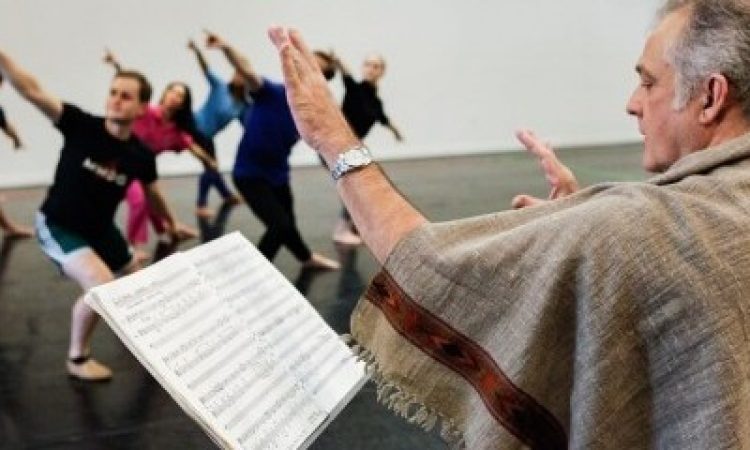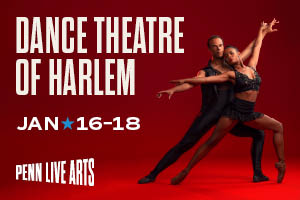I’m visiting my family in Pittsburgh for Thanksgiving, and the holiday spirit is starting to build. I haven’t yet put on The Nutcracker soundtrack, but that’s not far off. Unlike many former ballerinas, my years of performing in the holiday classic fill me now with delighted nostalgia rather than traumatized groans.
I’ve just finished savoring Mark Morris’ new memoir, Out Loud, and I’m not sure how to encapsulate its wild ride through the life and work of this singular choreographer. So, I take to YouTube to watch excerpts of Morris’ choreography, hoping an angle will come to me. After several clips, I find a 360 video of “Waltz of the Snowflakes” from The Hard Nut, Morris’ 1991 take on The Nutcracker. I call my mom in from the kitchen to watch with me (she shares my warm Nutcracker memories, having been a most enthusiastic and supportive Dance Mom).
We’re mesmerized. The seemingly endless cast enter and exit in a snowstorm of their own creation. In Morris’ “Snow,” the dancers toss handfuls of fake snow as they leap and swirl around the stage. Morris writes in Out Loud that “the rule is to enter the stage with your hands full and leave with them empty, every single time” (p. 245). This clever choice brings a jubilant energy to the dance, and the 360 video’s fisheye creates a snow-globe effect.
I realize I have tears in my eyes. I’ve been whirled back through years of fond performance memories, yes, but Morris’ particular brilliance has also swept me up in its bluster, as his memoir did. This six-minute dance has all the elements of his work that stand out to me from reading Out Loud—his bold individuality, his questioning of assumed norms, his relentless assertion of his standards and values, his elevation of the group above any individual, and his deep and reverent connection with music.
Morris’ rootedness in music is now well recognized (he has long insisted on using live music in his company’s performances), but Out Loud reveals that his devotion to music began in childhood. He writes, “One reason I make dances is to trick people into hearing music better” (p. 196). As “Snow” approaches its climax, the dancing embodies the music fully, with the dancers leaping and tossing snow on each beat of the clanging symbols. My mom and I clutch each other’s arms, unexpectedly moved and tricked into a new hearing of a score we’ve heard hundreds of times.
As described in Out Loud, Morris is known for drawing from his early and extensive involvement in folk dance in his concert dance works. In “Snow,” I see this in his removal of the Snow Queen soloist, choosing instead to focus on the collective, with no snowflake more important than another. Costuming dancers of all genders in the same tutus and giving the same movement to everyone furthers this group focus and reflects his trailblazing of progressive gender roles in dance.
The book matches Morris’ brashness with bold, effervescent writing, and mashes up personal stories with artistic reflections. I found this occasionally hard to follow, but I ultimately settled into the book’s ways of visiting an anecdote, staying with it for a few paragraphs, and zooming to the next, which could be years in the future or another subject entirely.
Morris declares resistance to sharing the “behind the scenes” of his making—the book’s opening line is “There’s an obsession with process that I don’t share,” and he is firm about keeping his rehearsals closed (p. 1). But he does reveal select stories behind the dances we see on stage and some of his process, which were among my favorite parts of the book. He also richly describes the early days of his scrappy company (rehearsing in Morris’ sewing-factory-turned-loft-apartment with stray needles on the floor) and gives an inside view from his place within a golden age of dance in New York City.
Morris, at 62, admits to considering his legacy, which seems to have driven the choice to write a memoir as well as announce his company’s formal legacy plan in 2018. Appropriately mischievous and subversive, he is choreographing dances now that will not be released until after his death, something of a time capsule of new works that the world must wait to receive. In Out Loud, he writes that his response to the idea for Dances for the Future from longtime Mark Morris Dance Group Director Nancy Umanoff was, “That’s the grisliest, most horrible, morbid thing I’ve ever heard of in my life. Yes!” (p. 356). Morris’ candor also impressed me when he discussed the need to adjust his behavior toward his company’s dancers, recognizing a much different power dynamic now versus working with his friends and peers early in his career.
I toggled between reading the physical book and the audiobook, read aloud by Morris himself—hearing the choreographer’s story in his own voice made the experience feel more like a conversation. Twice in the book, Morris uses the phrase, “because I’m me…” before describing an unexpected creative choice that makes things unnecessarily difficult, like insisting on real denim jeans instead of stretchy ones for a dance to country music. To me, this reflects his near-fanatical commitment to authenticity and excellence and intense clarity of vision—qualities that make Morris one of the most celebrated living modern dance choreographers. Everything described in Out Loud happened because he is him, and I for one am deeply glad that he is.
Previous coverage of Mark Morris Dance Group on thINKingDANCE: https://thinkingdance.net/articles/2018/02/13/Mark-Morris-Magic-Returns-to-Philadelphia/
Mark Morris and Wesley Stace, Out Loud: A Memoir. New York: Penguin Press, 2019. 374 pp.






